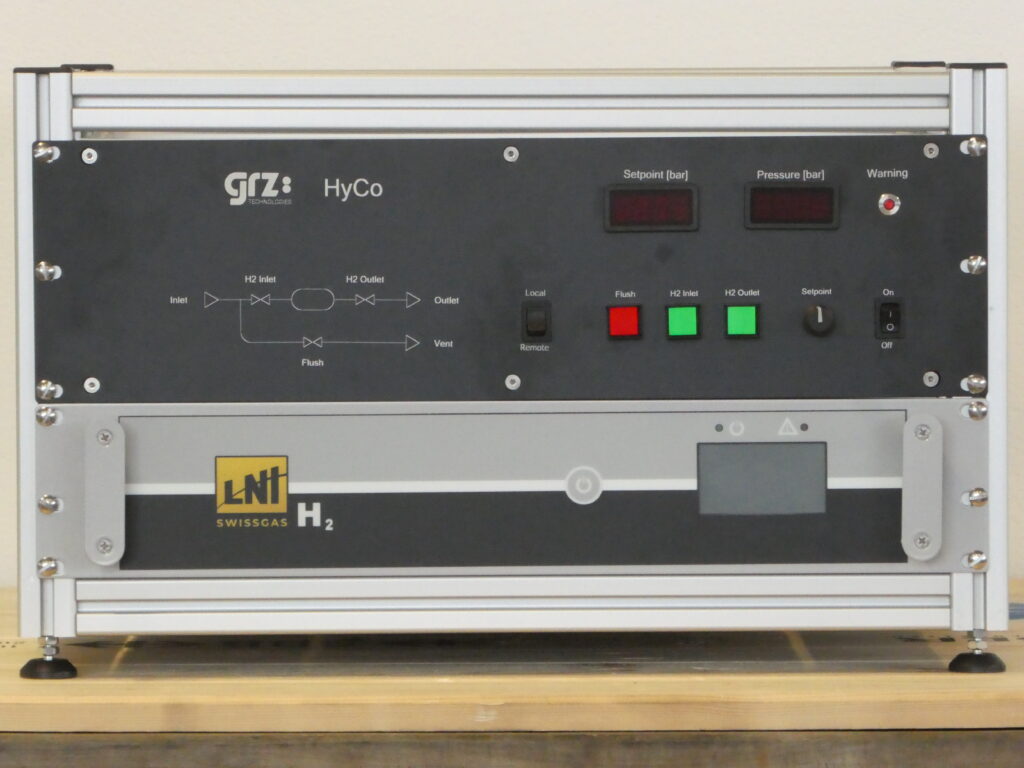Electrolyzers are devices that utilize electricity to split water or other electrolytes into hydrogen and oxygen. They implement a process called electrolysis. Various electrolyzer technologies exist, each with its own advantages, disadvantages, and characteristics.
Main categories #
The list below summarizes certain commonly used electrolyzer technologies to provide an overview:
- Alkaline Electrolyzers: They use a liquid alkaline electrolyte for the electrolysis process, typically a solution of potassium hydroxide (KOH). The systems operate at relatively high temperatures and usually produce hydrogen at medium pressures of 10-30 bar(g). They have been used for several decades. Alkaline electrolyzers are efficienct, durable, and relatively low cost. Certain variants produce hydrogen just above ambient pressure.
- Proton Exchange Membrane Electrolyzer (PEM): PEM electrolyzers use a solid polymer electrolyte membrane, such as Nafion, which selectively allows the transport of protons (H+). PEM electrolyzers operate at lower temperatures and higher pressures of 30-40 bar(g) compared to alkaline electrolyzers. They offer rapid response times, high efficiency, and flexibility for dynamic operation. The image below shows a lab-scale version together with a FLEXI HyCo storage compression device.
- Solid Oxide Electrolyzer Cell: This type of electrolyzer operates at high temperatures of typically above 600°C and use a solid ceramic electrolyte, such as yttria-stabilized zirconia (YSZ). The technology has the advantage of being reversible, meaning that an electrolyzer machine is at the same time also a fuel cell that can produce electricity from hydrogen.
- Anion Exchange Membrane (AEM) Electrolyzers: AEM electrolyzers utilize an anion exchange membrane as the electrolyte. AEM electrolyzers are an emerging technology in the field of hydrogen production and are gaining attention for their potential advantages over other electrolyzer technologies, in particular that they do not require rare metals such as other technologies.
- Photoelectrochemical Electrolyzer: This technology combines light-absorbing semiconductors and electrochemical processes to drive the water splitting reaction. The electrolyzers use solar energy to generate the electricity needed for electrolysis, eliminating the need for an external power source.

Applications #
In today’s relatively early phase of industry development, no clear technology preference for each application has emerged. However, typical applications for each technology are summarized below:
- Alkaline Electrolyzers are commonly used in large-scale industrial applications and for hydrogen production, but new versions can also be used in connection with renewable energy sources.
- PEM electrolyzers are suitable for various applications, including renewable energy storage, hydrogen fueling stations, and small-scale distributed systems.
- Solid Oxide Electrolyzer Cell are often described as a suitable technology for large-scale applications in which high-temperature heat sources, such as excess waste heat or renewable energy, are available. The company Bloom Energy offers this technology and has erected relatively large electrolyzers based on it.
- Anion Exchange Membrane (AEM) Electrolyzers are an emerging technology with only one solution commercially available today. An example of an AEM application in a GRZ project is the EWB project.
- Photoelectrochemical Electrolyzer are still in an early stage of development, but hold the promise for sustainable and direct solar-driven hydrogen production.
Conclusion #
Each electrolyzer technology has its own set of advantages, including efficiency, operating conditions, scalability, and cost. The choice of electrolyzer technology depends on factors such as the application, scale of production, available infrastructure, and specific requirements of the system. GRZ has integrated different manufacturers from lab to MW-scale and can help you realize your project successfully.





